Table of Contents
Invalid and Infant Feeders
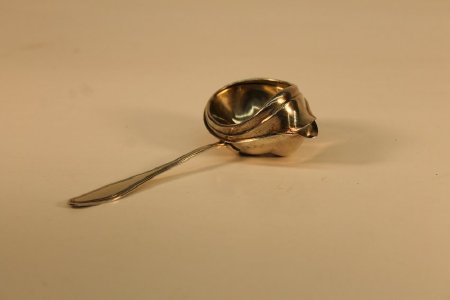
- Invalid Feeder
- EH102140
-
- Victorian era sterling silver invalid feeder.
Invalid feeders were used from the 17th century until the 1930s to feed both invalids and infants when they were unable to feed themselves. A mixture called pap was made using bread, honey, and mil... View Full Record
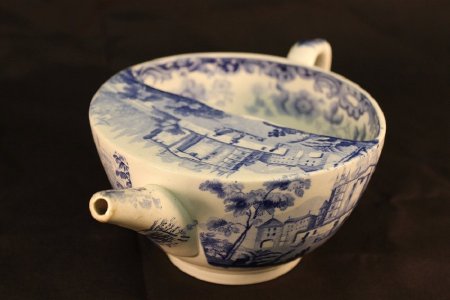
- Invalid Feeder
- EH102142
-
- Blue transfer printed design is on and around the outer shell of the invalid feeder. It is made out of pearlware. The flat cover extends halfway across the top, while the other half is without a cover and the inside is designed with transfer printed... View Full Record

- Invalid Feeder
- EH102143
-
- A set of 7 invalid feeders. All invalid feeders in this collection are painted with a blue design reminiscent of the ever popular "Blue Onion" design.
The Blue Onion design was orignially made in China and was exported, along with other blue and wh... View Full Record
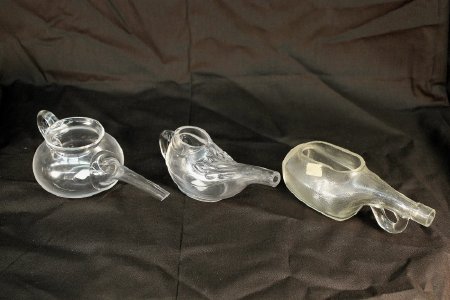
- Invalid Feeder
- 2017.000.041
-
- A set of three glass invalid feeders. Glass feeders were fairly popular in the early 19th century, but were shortly replaced by ceramics. Because of the lack of makers' marks, however, it is difficult to date these particular feeders that far back. ... View Full Record
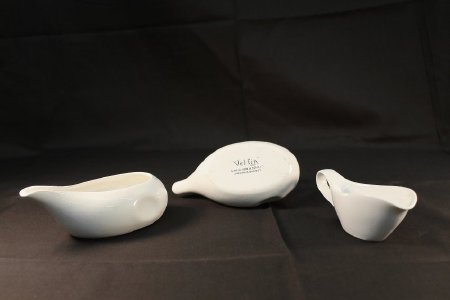
- Invalid Feeder
- EH102145
-
- Set of three white pap-boats. Pap-boats are a type of invalid feeder generally used to feed the invalid or child pap: a mixture of soaked bread with meal and sugar, sometimes chewed by a nurse to get the right smooth consistancy.
A-B) Production D... View Full Record
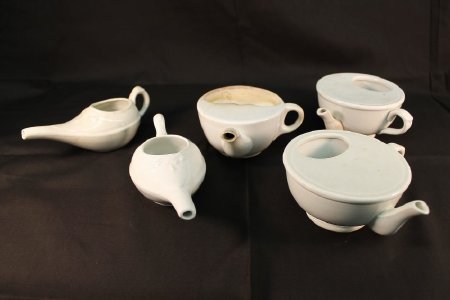
- Invalid Feeder
- 2017.000.050
-
- A set of five stoneware (or, Iron Stone China) invalid feeders. Stoneware has been used for thousands of years, but became popular in England in the early 19th century as an alternative to earthenware, especially porcelain. Stoneware was significantl... View Full Record
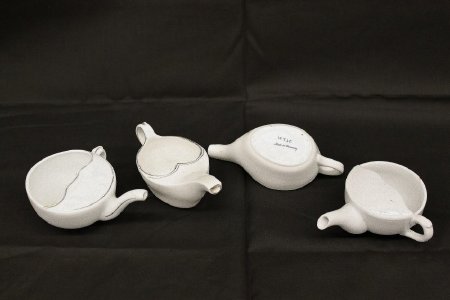
- Invalid Feeder
- EH102147
-
- Set of four half-covered white invalid feeders. All porcelain.
A) Production Date: 1875-1925
Small porcelain invalid feeder with gold trim. The spout is curved and located near the bottom of the cup and the half-cover on top is flat. The number... View Full Record
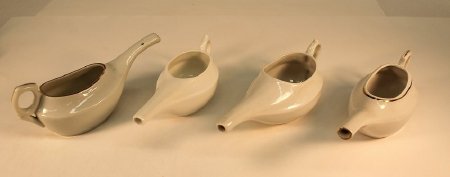
- Invalid Feeder
- EH102148
-
- Set of four porcelain pap boats. Pap boats are a type of invalid feeder generally used to feed the invalid or child pap: a mixture of soaked bread with meal and sugar, sometimes chewed by a nurse to get the right smooth consistancy.
A) Production... View Full Record
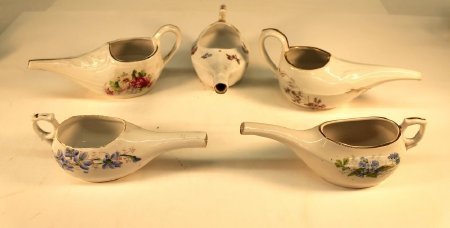
- Invalid Feeder
- EH102149
-
- Set of five white porcelain pap boats with gold trim and curved spouts. Pap boats are a type of invalid feeder generally used to feed the invalid or child pap: a mixture of soaked bread with meal and sugar, sometimes chewed by a nurse to get the righ... View Full Record
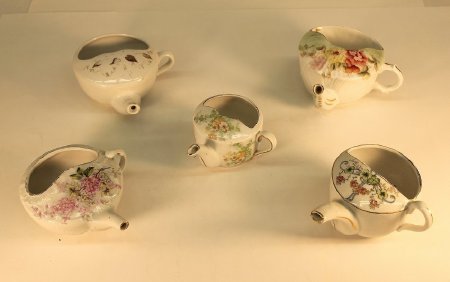
- Invalid Feeder
- EH102150
-
- Set of five porcelain invalid feeders. All have designs on the half-cover via transfer printing. Transfer printing was developed in England in the mid-18th century and involves printing a pattern on a tissue via a copper plate and then transfering it... View Full Record
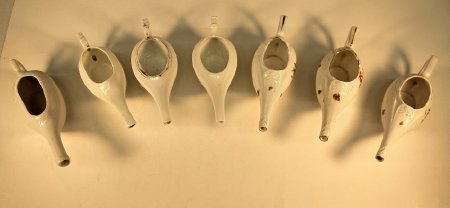
- Invalid Feeder
- EH102151
-
- Set of seven white porcelain pap boats with curved spouts. Pap boats are a type of invalid feeder generally used to feed the invalid or child pap: a mixture of soaked bread with meal and sugar, sometimes chewed by a nurse to get the right smooth cons... View Full Record
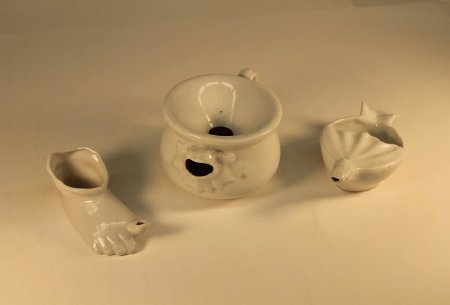
- Invalid Feeder
- EH102152
-
- Set of three white porcelain invalid feeders molded into unique designs. Due to these designs these feeders were most likely used for young children.
A) Production Date: 1800-1930
Porcelain feeder in the shape of a right foot. Big toe is pointed... View Full Record

- Invalid Feeder
- EH102153
-
- Set of three white porcelain pap boats. Pap boats are a type of invalid feeder generally used to feed the invalid or child pap: a mixture of soaked bread with meal and sugar, sometimes chewed by a nurse to get the right smooth consistancy.
A) Pro... View Full Record
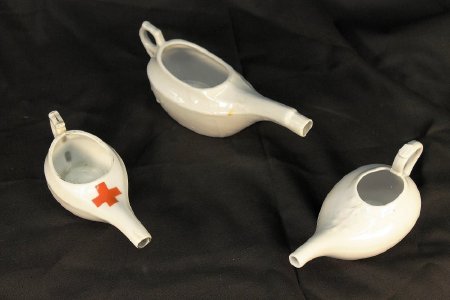
- Invalid Feeder
- EH102154
-
- Set of three white porcelain pap boats. Pap boats are a type of invalid feeder generally used to feed the invalid or child pap: a mixture of soaked bread with meal and sugar, sometimes chewed by a nurse to get the right smooth consistancy.
A) Prod... View Full Record
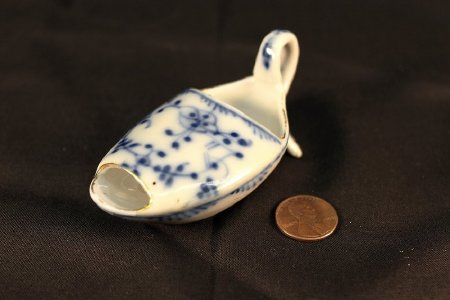
- Invalid Feeder
- EH102155
-
- Production Date: 1765-1880. Small porcelain invalid feeder with gold trim. Cover and handle are hand-painted with one of the many Blue Onion patterns. Bottom of handle flairs out like a fish fin to balance the feeder when placed on a surface.The flai... View Full Record

- Invalid Feeder
- EH102156
-
- Large porcelain invalid feeder with a short, curved spout attached near the top of the cup. The entire feeder is covered in a blue design via transfer printing. Transfer printing was developed in England in the mid-18th century and involves printing... View Full Record

- Invalid Feeder
- EH102157
-
- Refined earthenware pap boat with straight spout. Pap boats are a type of invalid feeder generally used to feed the invalid or child pap: a mixture of soaked bread with meal and sugar, sometimes chewed by a nurse to get the right smooth consistancy. ... View Full Record
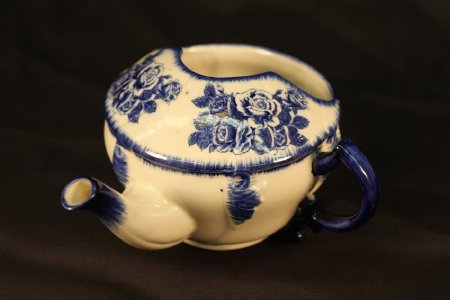
- Invalid Feeder
- EH102158
-
- Large refined earthenware invalid feeder. Spout is curved and attached towards the bottom of the cup. Handle is attached at the side. Convex half-cover includes a printed blue rose pattern via transer printing. Rim, handle, tip of the spout, and engr... View Full Record
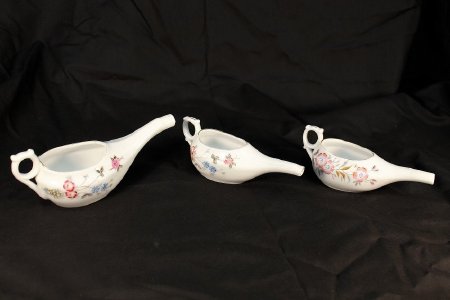
- Invalid Feeder
- EH102159
-
- Set of three porcelain pap boats with gold trim. Each have a hand-painted pink flower design. Spouts are curved and handles are attached near the top of the feeder.
A) Production Date: 1875-1930
Large pap boat with pink, blue and yellow flowers... View Full Record
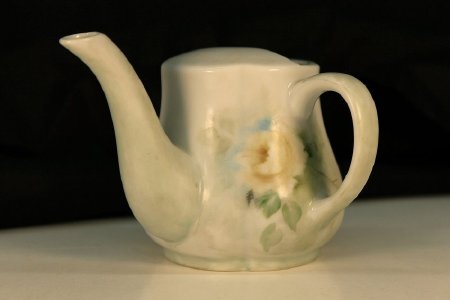
- Invalid Feeder
- EH102160
-
- Porcelain invalid feeder that looks like it should be in a tea set, rather than a hospital. Half cover is slightly convex and spout is attached near the bottom of the cup and slightly curved. Handle is attached perpendicular to the spout.
A lightly... View Full Record
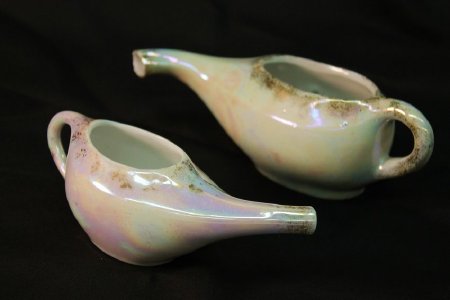
- Invalid Feeder
- EH102161
-
- Two delicate porcelain pap boats with spouts curved out to the side, rather than up or down. The feeders are given a very interesting design via a reduced glaze luster. This specific type of reduction glaze was generally seen after 1870 in Europe. Bo... View Full Record




















